BACK
TO
WEATHER-BLOG
MENU
New!
Fine
Art
Prints
&
digital
images
for
sale-
Welsh Weather
& Dyfi Valley landscapes Slide-Library - Click HERE
Here's
a
post
about
my old stamping-ground, where I first started collecting
minerals as an Aberystwyth geology undergraduate in the early 1980s and
then went on to do an MPhil on the mineralogy of the old metal-mines
that are scattered through the hills and valleys of Mid-Wales. Back
then, many of the mines were still recognisable as such, although in
the intervening years there have been many land reclamation-schemes
that have changed things. However, up in the mountains there are still
plenty of mines tucked-away in remote valleys or hidden away in
forestry plantations. They are peaceful spots where the long labours of
yesteryear may be contemplated on a quiet evening......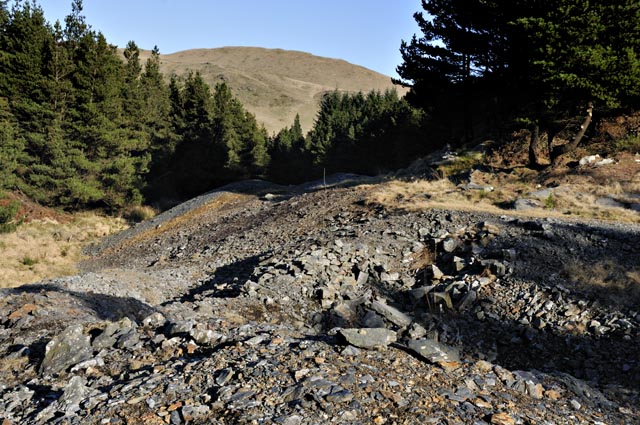 Mining commenced in Mid-Wales during the Bronze-Age, when copper was primarily sought in shallow surface workings. Later, the Romans mined and smelted lead in places, whilst the 1600s saw great activity and wealth-generation from the high silver-contents of some of the lead-ores. The 1800s marked the heyday of the industry, which dwindled away during the 1900s with the development of much bigger mines overseas, and today all that is left are these silent remains. 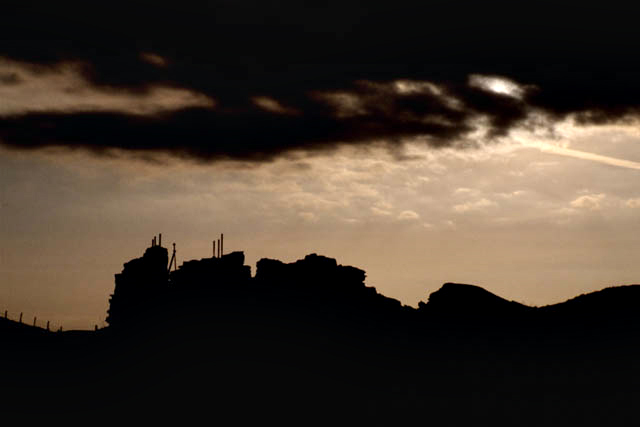 As the image above shows, they can make striking, almost abstract subjects for photography in the right lighting-conditions. The mines all worked lodes. A lode is a fracture in the rocks, ranging in width from a few inches to tens of feet and filled with bits of smashed-up rock cemented together with minerals: the filling is often termed "mineralised breccia". A breccia (pronounced "brechia") is simply a mass of rock fragments cemented back together. The image below shows an example - it's a cut and polished slab about a foot across. Grey pieces of mudstone are cemented by zinc-blende (zinc sulphide - brown) and quartz (white). There would have been quite an earthquake when this lot was smashed up.... 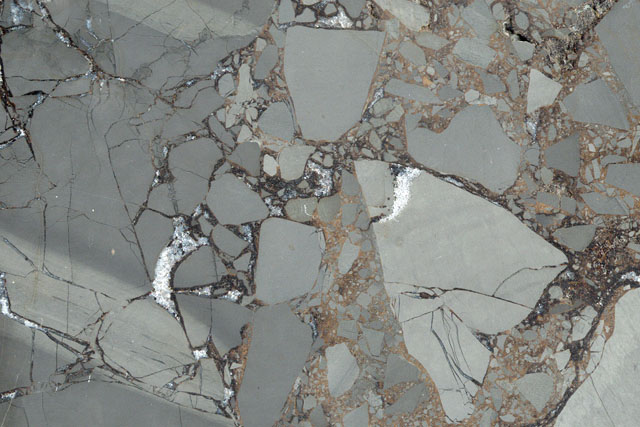 Here's an example, again about a foot across, of shattered grey banded mudstone, cemented by the lead sulphide, galena (black) with iron-rich dolomite (yellow) and quartz (white). This is low-grade ore: the stuff that made the area famous consisted of solid galena, carrying 30-40 ounces of silver to the ton, in veins 1-3 feet thick or even more on occasion. Not all mines revealed such riches and a lot of money was lost, as well as made, at times! 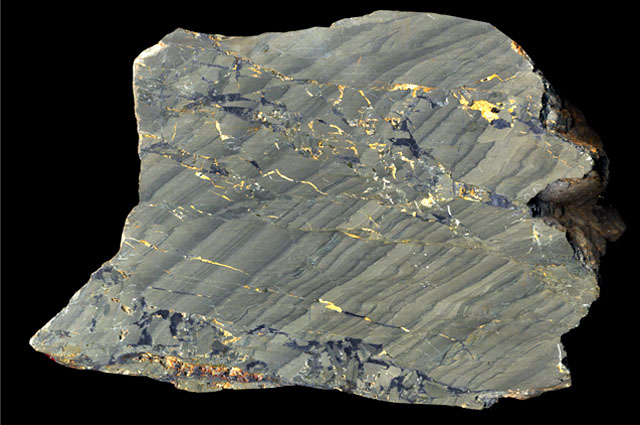 Unsurprisingly, it is unusual to find boulders of high-grade ore on the old tips of the mines, but samples representative of the ore-deposits can still be collected for study. After I graduated in 1985, I spent about a year wandering the hills and collecting samples and eventually it was suggested that I did a postgraduate research-degree on the area. The chance to use the facilities of the Geology Department at Aberystwyth was jumped-at. Here were diamond-saws of all sizes, grinding wheels, a polishing-machine (in bits - I rebuilt it), an X-Ray diffractometer and a host of other useful bits of kit. Paradise for an up-and-coming researcher with a hands-on approach, in other words! One thing I had started noticing as I hammered my way around the old mine-tips was that there were a number of minerals that I was unfamiliar with and it rapidly dawned on me that previous studies of the area had missed many interesting things. The sample below shows golden-yellow chalcopyrite - a common ore of copper - but with it is a fine-grained pinkish metallic mineral. I found enough of this to be able to prepare samples for X-ray diffraction - these days a tiny speck will do but back then about a gram was needed! The mineral proved to be an uncommon sulphide of nickel and cobalt called siegenite. 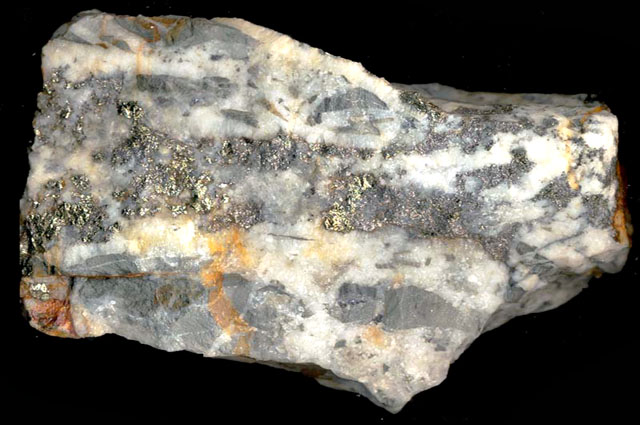 With rather fine-grained mixed minerals like this, the next step was ore microscopy. Geologists look at the microscopic characteristics of rocks using thin sections (below, left). But most ore minerals are opaque to transmitted light, so that method is no good. What we do instead is to embed a chip of ore in liquid resin. When it has cooked-off, the front of the block is ground flat then painstakingly polished on laps in a squeaky-clean environment with decreasing grades of diamond paste. The final polishing is done with a diamond paste with no diamond bigger than half a micron in size! A finished section - the research involved making over 300 of these - is illustrated below right. Once polished like this, the ore can be examined using a reflected light microscope. 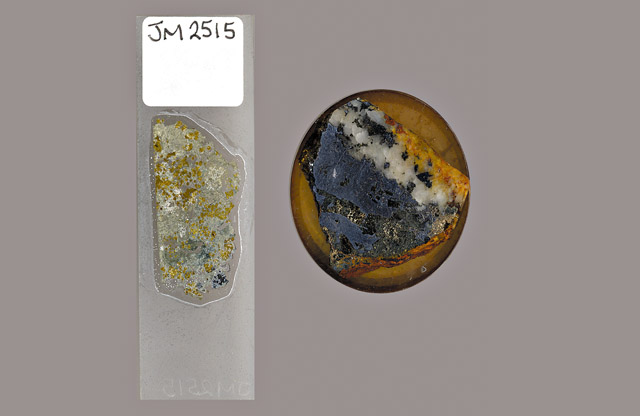 Here's a polished section, as seen down the microscope. From Eaglebrook mine - the one in the photo at the top of the page - this is a particularly interesting sample. The common ore-minerals galena (G), chalcopyrite (C) and pyrite (P) are accompanied by bright yellow electrum (E) - a gold-silver alloy and very rare in this part of Wales. It's about 0.1mm across so this is high-magnification! The buff-coloured mineral (T) is the most noteworthy, though. To identify it, I had to take samples to the laboratories of the British Geological Survey near Nottingham, where technical staff helped me to analyse it with an electron microprobe and a sophisticated X-Ray diffractometer. The mineral turned out to be the extremely rare nickel-antimony sulphide tucekite - the first UK occurrence and only the third occurrence anywhere in the world at the time. By the time the research was completed, the thesis submitted and papers prepared for the peer-reviewed literature (references 1 and 2), a lot of minerals new to the area had been discovered and the sequence of events leading to the formation of the primary ore mineralisation had been unravelled to a great extent. Later, the British Geological Survey and I worked on isotopic dating using the lead isotopes in the galena. We found that there had been episodes of mineralisation beginning in the Middle Devonian Period (~390 million years ago), in the early Carboniferous Period (360-330 million years ago) and the Permian and Triassic Periods (250-225 million years ago). 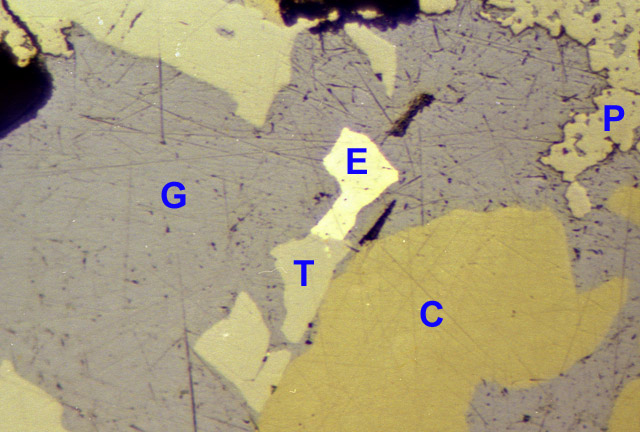 At the same time, the old mines had drawn a steady stream of visitors interested in the area's secondary minerals. Secondary minerals form when the primary metal sulphides in a mineral deposit, such as a lode, react with rain and ground-water. Such waters are slightly acidic already - they contain dissolved carbon dioxide - and when they react with sulphides the sulphur is mobilised as even more reactive sulphuric acid, which can also attack the rocks surrounding a lode, releasing things like phosphorus, silica and so on to the system. The metals go into solution and are then redeposited as colourful secondary minerals - for example, carbonates, sulphates, oxides and phosphates in various combinations. The example below is well-crystallised pyromorphite, a chloro-phosphate of lead, for which the area is famous.  Large, well-crystallised specimens of secondary minerals were never that common, though, and with increased availability of affordable binocular microscopes, many collectors turned their attention to unusual and rare minerals which formed microcrystals of 1mm or less in size. As a consequence, a host of rare minerals was again recorded: the image below shows crystals of the very rare copper-zinc sulphate ramsbeckite, from a chance find that I made in 1992 (reference 3). Through the 1990s, discovery after discovery occurred, so that when, in 2004-5, we updated the Mineralogy of Wales in website format (reference 4; the original book was published in 1994), there was plenty of stuff to add! Specimens like the ramsbeckite below reveal thin crystalline coatings involving fractions of a gram of mineral. I started to get interested in finding out why, at certain mines, there was much more secondary mineralisation than at others. We knew that minerals like ramsbeckite formed over the few centuries since sulphide-bearing rocks were brought to surface and dumped in mine-tips. Why, at some mines, were there just thin coatings of secondary minerals, whilst at others, they occurred in big, solid masses? This question started off another line of research. 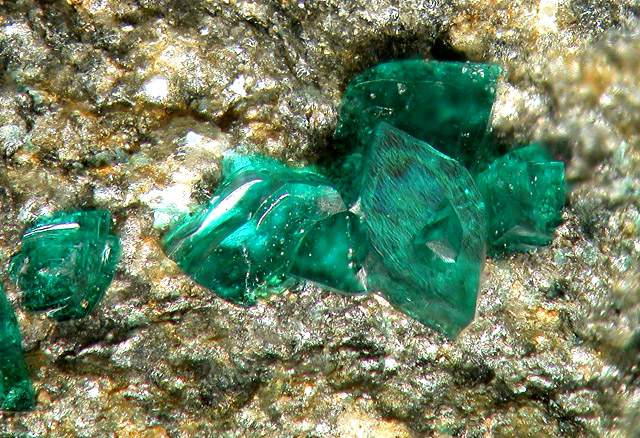 The sample below, the size of a really large fist, is just such an example of a big, solid mass of secondary minerals. Here we have brown iron oxides with lots of pale blue chrysocolla (copper silicate) and green malachite (copper carbonate). Material like this occurred in abundance in a wide lode at the bottom of one valley - yet just four valleys away, at the entrance to a shaft in Cwm Rheidol, unweathered sulphides, including the incredibly unstable mineral marcasite, were present at surface. What was going on?  Another thing I started to record on a regular basis was the coincidence of large amounts of secondary minerals with bleached mudstone. In the image below, iron oxide contains large amounts of the white lead carbonate, cerussite. At the bottom right is a 2-inch fragment of mudstone, but it is not the drab grey colour of the rocks around here - it has a much paler, bleached appearance. 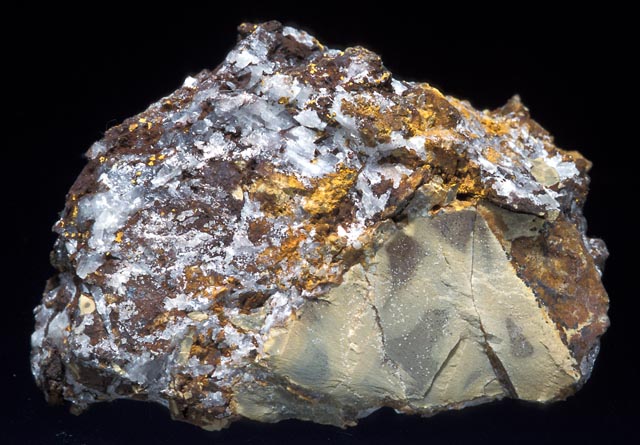 Below is a typical outcrop of the local grey mudstones.... 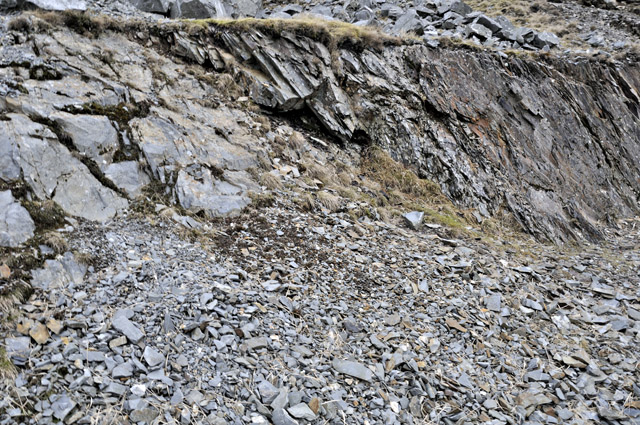 Here is a part-bleached chunk from a mine-tip: the bleaching has worked its way into the rock along tiny cracks.... 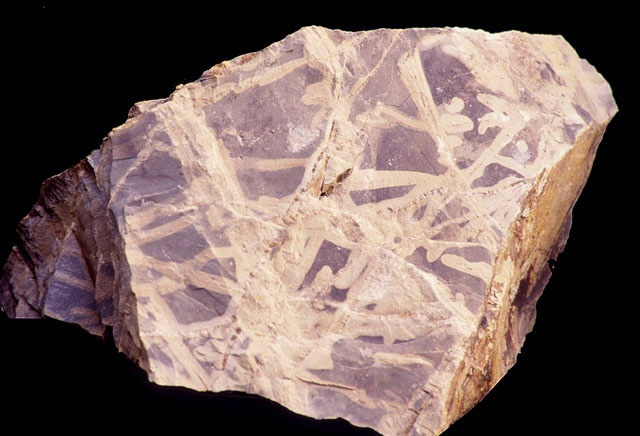 And here is a fully-bleached example - from dark grey to shades of pinkish-buff. 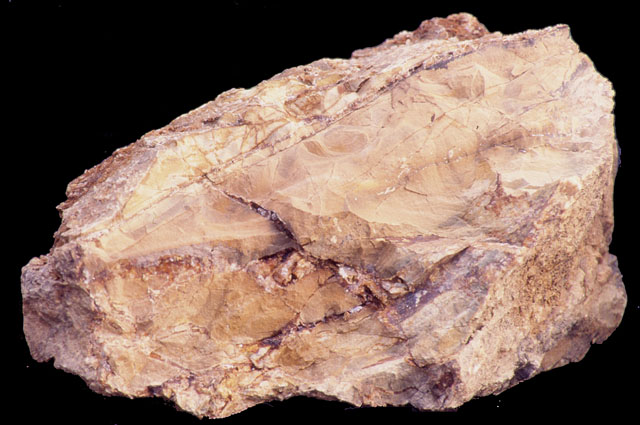 In some places, the bleached rock was accompanied by manganese oxides that were mined where they were present in quantity. The photo below is the hill called Drosgol, looking across the Nant-y-moch reservoir. There are tips just above the small beach across the lake, beyond which a prominent gully heads off uphill. The gully marks the course of one of the main lodes of the area and just over the skyline, 450-500 metres above sea-level, there are collapsed tunnels and pits where the manganese was dug.... 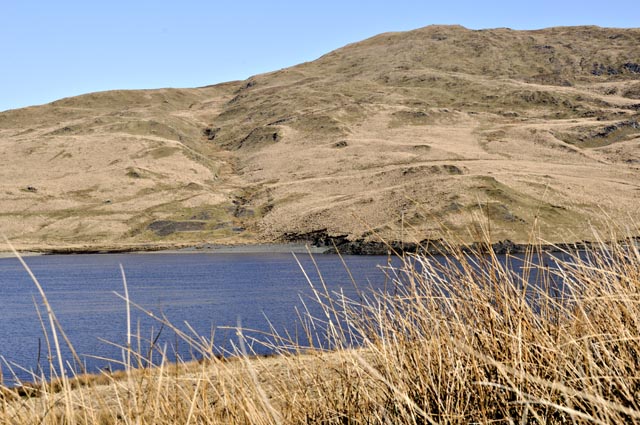 ...and this is the ore (below) together with pinkish, bleached mudstone. The ore mineral is mostly chalcophanite - an oxide not only of manganese but also of zinc - which diluted the manganese grade, as a consequence of which the operations were not successful. Looking further afield, the same thing kept on cropping up. At various scattered locations across Snowdonia, for example, there are similarly pale, bleached rocks accompanied by manganese oxides. 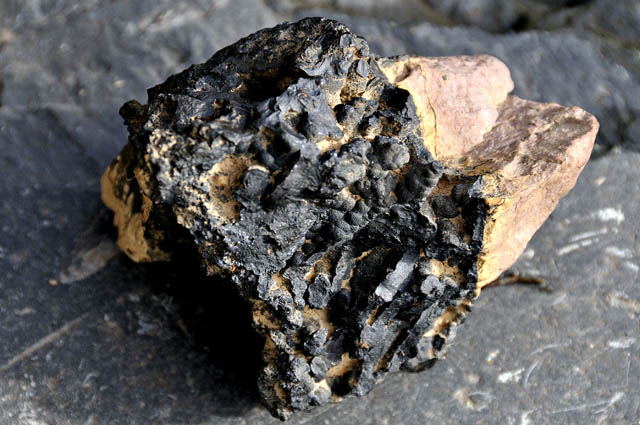 The black mineral in this image is hollandite - a barium manganese oxide, veining volcanic tuff (that should normally have been a greeny-grey colour), from the Arenigs, between Bala and Trawsfynydd, where again, manganese was mined in the 1800s. 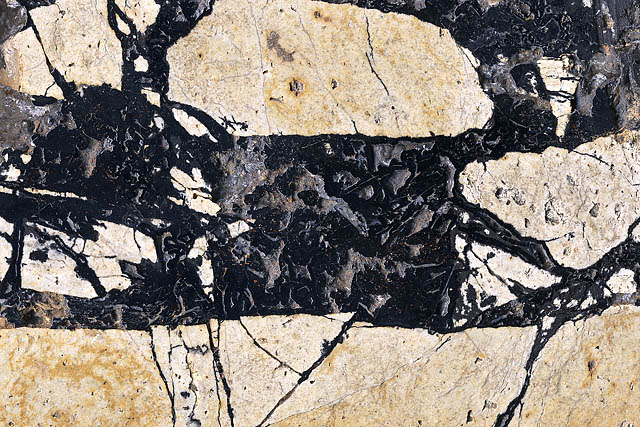 So: in some places, totally bleached rocks with masses of secondary oxides, but in others, fresh, unweathered rocks and even fresh, unweathered sulphides outcropping at surface. 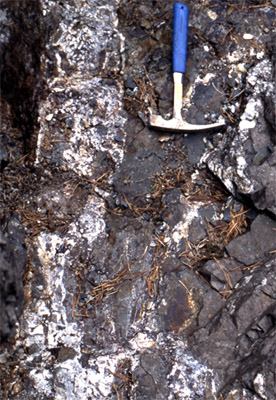 This image shows just such an occurrence: it
is at Ceulan mine in the NE of the mining district. Just a metre below
the original ground surface, this is a pillar left in a small opencast
working. The grey mudstone carries a lode with quartz (white) and the
lead sulphide galena (bluey-grey, most obvious towards the bottom of
the image). The only weathering it displays is a slight tarnish.
Compare that to some of the images just above! This image shows just such an occurrence: it
is at Ceulan mine in the NE of the mining district. Just a metre below
the original ground surface, this is a pillar left in a small opencast
working. The grey mudstone carries a lode with quartz (white) and the
lead sulphide galena (bluey-grey, most obvious towards the bottom of
the image). The only weathering it displays is a slight tarnish.
Compare that to some of the images just above!The fact that such fresh, unweathered sulphides outcrop at surface in many places can only mean one thing: they have been exposed at the surface relatively recently (geologically speaking), for the pervasive weathering that accompanies the manganese oxides can take millions of years to accomplish. To expose unweathered sulphides at surface, we need a powerful agent of mechanical erosion to remove most of the weathered rocks above, and one that was last active only a few thousand years ago: and indeed we have just such a candidate - the glaciers of the last ice-age. The last glacial maximum was only 18,000 years ago (a blink in terms of geological time). The Welsh mountains had ice-caps hundreds of metres thick and glaciers flowed outwards from them, carving out the valleys. Under the centres of the ice-caps, ice-movement was minimal, but countless billions of tonnes of rock were removed by the mechanical erosion of the ice along their flanks. It seemed reasonable to cite this erosional activity as responsible for stripping away the upper, weathered parts of lodes in many places to the point that fresh sulphides were once again exposed at surface, a point that I made in a paper published in 2004 (reference 5). But what about the weathering itself? Deep weathering, that pervasively turns dark grey mudstones into yellows and pinks, has certainly not occurred in the cool temperate climate we have had since the last ice-age - the rocks are just as grey now as they were when the ice retreated! Such weathering is more normally found in the tropics, where it penetrates hundreds of feet down into the rocks. So you need the environment to be one of dry land, with a tropical climate. When did Wales last see such conditions? Palaeogeography involves taking numerous lines of evidence to reconstruct how the planet would have looked in the past. Now, we know that the primary mineral deposits were forming into the Triassic Period, so we have narrowed down the field, between when they formed and when the glaciers stripped away a lot of the weathered material, just leaving a few remnants here and there, Wales was at least partly land during the Jurassic Period and the uplands may even have escaped the almost total inundation of the Upper Cretaceous sea from which the Chalk was formed. Here's how things looked back then (globes - see reference 6): 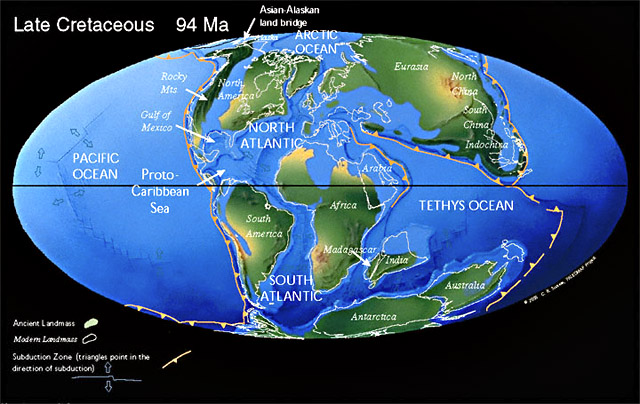 By the following Cenozoic era, which began 65 million years ago, the continents were drifting towards their present position, although the Atlantic was much narrower than it is today: 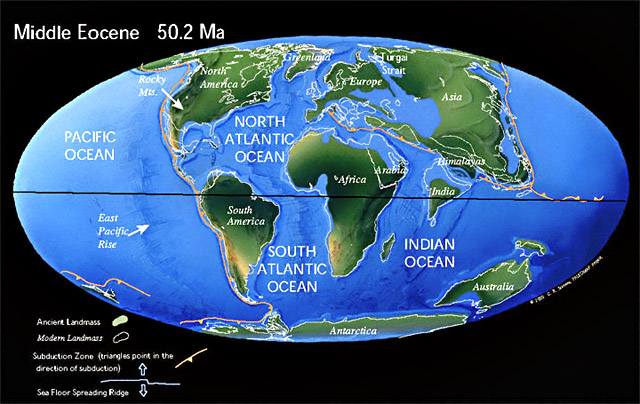  Here's a sketch-map of Eocene Britain. The sea covers the eastern half of the country - this is when the marine London Clay was deposited - but western areas were emergent throughout the time. Now, this time, beginning about 65 million years ago, is a candidate for the period of deep-weathering. So what was the climate like? It was indeed tropical - and not just in the UK either: it was pretty warm well to the north, too. There are numerous lines of evidence for this, one compelling one being what the fossil record shows. Here's an example of some recent research findings, compiled from Reference 7: Today, Ellesmere Island - which is adjacent to Greenland - is one of the coldest, driest environments on Earth and features tundra, permafrost, ice sheets, sparse vegetation and few mammals. The temperatures range from roughly minus 37 degrees F in winter (minus 38 C) to 48 degrees F (8 degrees C) in summer. During the Eocene, Ellesmere Island was probably similar in nature and climate to swampy cypress forests in the southeastern United States today. Eocene fossil evidence collected there in recent decades by various teams indicate the lush landscape hosted giant tortoises, aquatic turtles, large snakes, alligators, flying lemurs, tapirs, and hippo-like and rhino-like mammals. The average temperatures of the warmest month on Ellesmere Island during the early Eocene were from 66 to 68 degrees Fahrenheit (19-20 degrees C), while the coldest month temperature was about 32 to 38 degrees F (0-3.5 degrees C). The diagram below plots the fluctuations of climate through the whole Cenozoic: 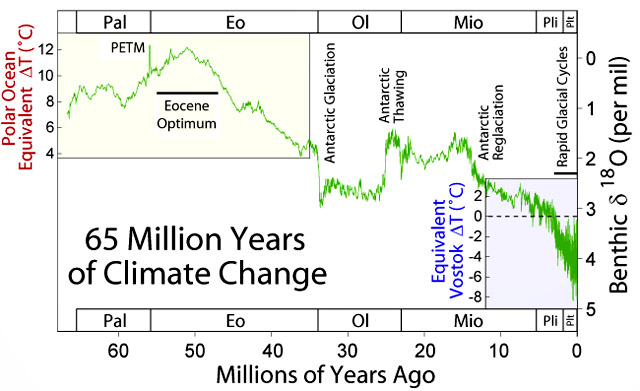 The diagram shows how warm conditions persisted right through the Eocene, only falling off sharply at its boundary with the succeeding Oligocene (Ol). Really cool conditions did not come along until the late Miocene, when the plunge downwards towards the ice-ages and their glacial-interglacial cycles commenced. Truly tropical conditions (reference 8) are today found close to the equator, where temperatures rarely exceed 35 degrees C by day and rarely fall below 22 degrees C by night. Well, at a time when Ellesmere Island way up in the north was seeing 19-20 degrees C in summer, it seems quite possible that what is now the UK could have had temperatures at least within the lower levels of the tropical span of 22-35 degrees C during at least parts of the Palaeocene and Eocene, so that tropical and sub-tropical weathering took place. Reference 9 covers another of many cited cases of such deep, tropical weathering from nearby South-West England - it's just another of very many examples. The old metal mines of Central Wales and elsewhere are of great interest to the historians of industry, but the minerals that their spoil-heaps contain provide an extremely important Earth Sciences research-resource. As a consequence, the most important old mines of Central Wales are now protected as Sites of Special Scientific Interest, to prevent them from being levelled out of existence, as has happened to other sites in the past. Reference 10 is a comprehensive guide to the mineralogical SSSIs of Central Wales and elsewhere, and extensive sample suites from the mines (including my thesis collection) are preserved at the National Museum of Wales in Cardiff. The story told by the minerals in this post is just one of many themes: others include the evolution through time of crustal, fluid and tectonic processes, how heavy metals are mobilised and locked-up again in the natural environment and what concentrates metals into deposits that may economically be mined. But who would have thought that they might tell us about the climates of the past, too? References: 1) Mason, J.S. 1997. Regional polyphase and polymetallic vein mineralisation in the Caledonides of the Central Wales Orefield. Transactions of the Institution of Mining and Metallurgy (Section B: Applied Earth Science), 106, B135-B144. 2) Mason, J.S. 1998. Tucekite, a mineral new to Britain, and other rare ore minerals from the Central Wales Orefield. U.K. Journal of Mines and Minerals, 19, 30-36. 3) Mason, J.S., and Green, D.I. 1995. Supergene minerals including exceptional ramsbeckite from Penrhiw Mine, Ystumtuen, Dyfed. U.K. Journal of Mines & Minerals, 15, 21-27. 4) Mineralogy of Wales: http://www.museumwales.ac.uk/en/791/ 5) Mason, J.S. 2004. The development and preservation of supergene lead mineralisation in Central Wales. UK Journal of Mines and Minerals, 24, 35-46. 6) http://www.scotese.com/earth.htm 7) http://www.colorado.edu/news/r/475370cb045bebb0fc62504cc72f9737.html 8) http://www.ace.mmu.ac.uk/eae/english.html 9) Isaac, K.P. 1983: Tertiary lateritic weathering in Devon, England, and the Palaeogene continental environment of South West England. Proceedings of the Geologists' Association, Volume 94, Issue 2, 105-114; Abstract. 10) Bevins, R.E., Young, B., Mason, J.S., Manning, D.A.C. and Symes, R.F. (2010) Mineralization of England and Wales. Geological Conservation Review Series, No. 36, Joint Nature Conservation Committee, Peterborough. |
|
BACK TO WEATHER-BLOG MENU New! Fine Art Prints & digital images for sale- Welsh Weather & Dyfi Valley landscapes Slide-Library - Click HERE |